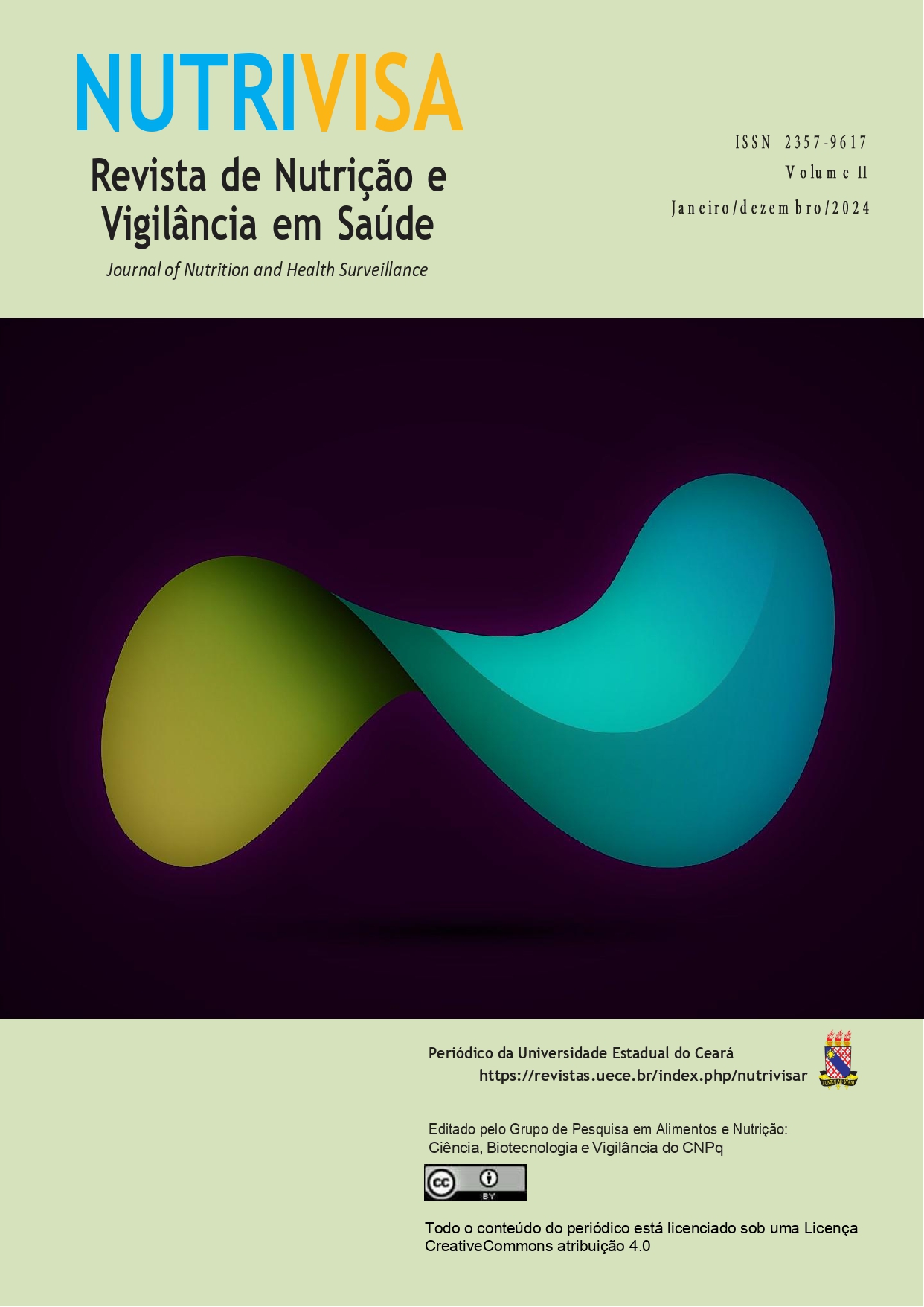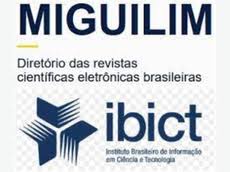Concentraciones séricas de ferritina y hemograma en adultos con sobrepeso en la región Sudoeste del Paraná
DOI:
https://doi.org/10.52521/nutrivisa.v11i1.13750Palabras clave:
síndrome metabólico, sobrepeso, ferritina sérica, recuento sanguineoResumen
La obesidad está relacionada con importantes alteraciones en el metabolismo del hierro, que parecen contribuir al empeoramiento de las comorbilidades asociadas con el exceso de tejido adiposo blanco, incluido el empeoramiento de la homeostasis glucémica y lipídica, favoreciendo la aparición del síndrome metabólico (SM). Este estudio transversal investigó el recuento sanguíneo y los niveles de ferritina (FS) sérica en 79 adultos (20-59 años) en la región Suroeste de Paraná. Se evaluaron variables socioeconómicas, antropométricas, de laboratorio y hábitos de vida. El Índice de Masa Corporal (IMC) indicó que el 67,09% presentaba sobrepeso, con circunferencia de cintura elevada, presión arterial sistólica, hiperglucemia, dislipidemia y resistencia a la insulina. Los sujetos con sobrepeso tuvieron mayor frecuencia de SM (30,39%) y riesgo cardiovascular (54,43%). Los análisis hematológicos mostraron que estos sujetos tenían valores elevados de hemoglobina, eritrocitos, hematocrito, leucocitos, plaquetas y FS, además de menores volumen corpuscular medio y hemoglobina corpuscular media en comparación con los sujetos eutróficos. El análisis de componentes principales reveló asociaciones significativas entre el aumento de la LM, los cambios en el recuento sanguíneo y el empeoramiento de las condiciones metabólicas en sujetos con sobrepeso. Se concluyó que el exceso de peso aumenta la FS, condición acompañada de anomalías metabólicas con mayor prevalencia en el SM, lo que indica que las anomalías en la homeostasis del hierro pueden ser parte de la fisiopatología del exceso de peso y deben incorporarse al análisis de salud de las enfermedades no crónicas. -transmisible.
Citas
ALSHWAIYAT, N.; AHMAD, A.; WAN HASSAN, W. M. R.; AL-JAMAL, H. Association between obesity and iron deficiency (Review). Experimental and Therapeutic Medicine, v. 22, n. 5, p. 1–7, 2021. doi: 10.3892/etm.2021.10703.
ASSOCIAÇÃO BRASILEIRA DE EMPRESAS DE PESQUISA (ABEP). Critério de classificação econômica Brasil. 2022. [Internet]. Acesso em: 10.06.2024. Disponível em: https://www.abep.org/criterioBr/01_cceb_2022.pdf.
BARBIERI, M.; RAGNO, E.; BENVENUTI, E.; ZITO, G. A.; CORSI, A.; FERRUCCI, L.; PAOLISSO, G. New aspects of the insulin resistance syndrome: Impact on haematological parameters. Diabetologia, v. 44, n. 10, p. 1232–1237, 2001. doi: 10.1007/s001250100634.
BARRETO, S. M.; LOTUFO, P. A.; PINHEIRO, A. R.; MONTEIRO, C. A.; ASSIS, A. M.; SCHMIDT, M. I. Análise da estratégia global para alimentação, atividade física e saúde, da Organização Mundial da Saúde. Epidemiologia e Serviços de Saúde, v. 14, n. 1, p. 41–68, 2005. doi: http://dx.doi.org/10.5123/S1679-49742005000100005.
BENSUSSEN, A.; TORRES-MAGALLANES, J. A.; ROCES DE ÁLVAREZ-BUYLLA, E. Molecular tracking of insulin resistance and inflammation development on visceral adipose tissue. Frontiers in Immunology, v. 14, p. 1-17, 2023. doi: 10.3389/fimmu.2023.1014778.
BOVOLINI, A.; GARCIA, J.; ANDRADE, M. A.; DUARTE, J. A. Metabolic syndrome pathophysiology and predisposing factors. International Journal of Sports Medicine, v. 42, n. 3, p. 199-214, 2021. doi: 10.1055/a-1263-0898.
BOYER, W.; TOTH, L.; BRENTON, M.; AUGÉ, R.; CHURILLA, J.; FITZHUGH, E. The role of resistance training in influencing insulin resistance among adults living with obesity/overweight without diabetes: A systematic review and meta-analysis. Obesity Research & Clinical Practice, v. 17, n. 4, p. 279-287, 2023. doi: 10.1016/j.orcp.2023.06.002.
BRODERSTAD, A. R.; MELHUS, M.; BRUSTAD, M.; LUND, E. Iron stores in relation to dietary patterns in a multiethnic population: the SAMINOR study. Public Health Nutrition, v. 14, p. 1039-1046, 2010. doi: 10.1017/S1368980010003289.
CALLAWAY, C. W. In: LOHMAN, T. G.; ROCHE, A. F.; MARTORELL, R., eds. Anthropometric Standardization Reference Manual. Champaign, Illinois: Human Kinetics Books, 1988. p. 39-54.
CAMASCHELLA, C.; NAI, A.; SILVESTRI, L. Iron metabolism and iron disorders revisited in the hepcidin era. Haematologica, v. 105, n. 2, p. 260–272, 2020. doi: 10.3324/haematol.2019.232124.
CAPUTO, T.; GILARDI, F.; DESVERGNE, B. From chronic overnutrition to metaflammation and insulin resistance: adipose tissue and liver contributions. FEBS Letters, v. 591, n. 19, p. 3061–3088, 2017. doi: 10.1002/1873-3468.12742.
CHENG, H. L.; BRYANT, C.; COOK, R.; O´CONNOR, H.; ROONEY, K.; STEINBECK, K. The relationship between obesity and hypoferraemia in adults: A systematic review. Obesity Reviews, v. 13, n. 2, p. 150-161, 2012. doi: 10.1111/j.1467-789X.2011.00938.x.
CHOI, K. M.; LEE, J.; KIM, Y. H.; KIM, K. B.; KIM, D. L.; KIM, S. G.; KIM, N. H.; PARK, I. B.; CHOI, D. S.; BAIK, S. H. Relation between insulin resistance and hematological parameters in elderly Koreans - Southwest Seoul (SWS) Study. Diabetes Research and Clinical Practice, v. 60, n. 3, p. 205–212, 2003. doi: 10.1016/s0168-8227(03)00059-7.
CHRISTAKOUDI, S.; TSILIDIS, K. K.; EVANGELOU, E.; RIBOLI, E. Associations of obesity and body shape with erythrocyte and reticulocyte parameters in the UK Biobank cohort. BMC Endocrine Disorders, v. 23, n. 1, p. 1-12, 2023. doi: 10.1186/s12902-023-01423-1.
COSTA, A. C. C.; IVO, M. L.; CANTERO, W. B.; TOGNINI, J. R. F. Obesidade em pacientes candidatos a cirurgia bariátrica. Acta Paulista de Enfermagem, v. 22, n. 1, p. 55-59, 2009. doi: 10.1590/S0103-21002009000100009.
COTRIM, H. P.; PARISE, E. R.; FIGUEIREDO-MENDES, C.; GALIZZI-FILHO, J.; PORTA, G.; OLIVEIRA, C. P. Nonalcoholic fatty liver disease Brazilian society of hepatology consensus. Arquivos de Gastroenterologia, v. 53, n. 2, p. 118–122, 2016. doi: 10.1590/S0004-28032016000200012.
COX, A. J.; WEST, N. P.; CRIPPS, A. W. Obesity, inflammation, and the gut microbiota. The Lancet Diabetes & Endocrinology, v. 3, n. 3, p. 207-215, 2015. doi: 10.1016/S2213-8587(14)70134-2.
DATZ, C.; MÜLLER, E.; AIGNER, E. Iron overload and non-alcoholic fatty liver disease. Minerva Endocrinologica, v. 42, n. 2, p. 173–183, 2017. doi: 10.23736/S0391-1977.16.02565-7.
DE SIQUEIRA VALADARES, L. T.; DE SOUZA, L. B. S.; SALGADO JÚNIOR, V. A.; DE FREITAS BONOMO, L.; DE MACEDO, L. R.; SILVA, M.. Prevalence of metabolic syndrome in Brazilian adults in the last 10 years: a systematic review and meta-analysis. BMC Public Health, v. 22, n. 1, p. 1-22, 2022. doi: 10.1186/s12889-022-13467-2.
DEPARTMENT OF HEALTH (DoH). Press Release: Reference 2000/0187. DoH, London, 2000.
DIRETRIZES BRASILEIRAS DE HIPERTENSÃO ARTERIAL – 2020 [Internet]. Acesso em: 10.06.2024. Disponível em: scielo.br/j/abc/a/Z6m5gGNQCvrW3WLV7csqbqh/?format=pdf&lang=pt.
DO VALE MOREIRA, N. C.; HUSSAIN, A.; BHOWMIK, B.; MDALA, I.; SIDDIQUEE, T.; FERNANDES, V. O.; MONTENEGRO JÚNIOR, R. M.; MEYER, H. E. Prevalence of metabolic syndrome by different definitions, and its association with type 2 diabetes, pre-diabetes, and cardiovascular disease risk in Brazil. Diabetes & Metabolic Syndrome: Clinical Research & Reviews, v. 14, n. 5, p. 1217-1224, 2020. doi: 10.1016/j.dsx.2020.06.030.
ELAGIZI, A.; KACHUR, S.; CARBONE, S.; LAVIE, C. J.; BLAIR, S. N. A review of obesity, physical activity, and cardiovascular disease. Current Obesity Reports, v. 9, n. 4, p. 571-581, 2020. doi: 10.1007/s13679-020-00406-6.
FACCHINI, F. S.; CARANTONI, M.; JEPPESEN, J.; REAVEN, G. M. Hematocrit and hemoglobin are independently related to insulin resistance and compensatory hyperinsulinemia in healthy, non-obese men and women. Metabolism, v. 47, n. 7, p. 831-835, 1998. doi: 10.1016/s0026-0495(98)90121-4.
FARMANFARMA, K. K.; KAYKHAEI, M. A.; MOHAMMADI, M.; ADINEH, H. A.; ANSARI-MOGHADDAM, A. The prevalence and trend of metabolic syndrome in the south-east of Iran. Journal of Medicine and Life, v. 13, n. 4, p. 587-599, 2020. doi: 10.25122/jml-2020-0118.
FRIEDEWALD, W. T.; LEVY, R. L.; FREDRICKSON, D. S. Estimation of the concentration of low-density lipoprotein cholesterol in plasma, without use of the preparative ultracentrifuge. Clinical Chemistry, v. 18, n. 6, p. 499–502, 1972. doi: 10.1093/clinchem/18.6.499.
FUNDAÇÃO GETÚLIO VARGAS - ESCOLA DE ECONOMIA DE SÃO PAULO. Obesidade e consumo das famílias brasileiras: diagnóstico e implicações para políticas públicas [Internet]. São Paulo: FGV; 2023. Acesso em: 08.06.2024. Disponível em: https://repositorio.fgv.br/server/api/core/bitstreams/06e7c5f3-7a45-405f-b9e2-ba5e244547a4/content.
GALDAS, P. M.; CHEATER, F.; MARSHALL, P. Men and health help-seeking behaviour: literature review. Journal of Advanced Nursing, v. 49, n. 6, p. 616–623, 2005. doi: 10.1111/j.1365-2648.2004.03331.x.
GANZ, T. Macrophages and Iron Metabolism. Microbiology Spectrum, v. 4, n. 5, p. 1–10, 2016. doi: 10.1128/microbiolspec.MCHD-0037-2016.
GHAZARIAN, M.; LUCK, H.; REVELO, X. S.; WINER, S.; WINER, D. A. Immunopathology of adipose tissue during metabolic syndrome. Turkish Journal of Pathology, v. 31, p. 172–180, 2015. doi: 10.5146/tjpath.2015.01323.
GONZÁLEZ-DOMÍNGUEZ, A.; BELMONTE, T.; DOMÍNGUEZ-RISCART, J.; RUIZ-OCAÑA, P.; MUELA-ZARZUELA, I.; SAEZ-BENITO, A.; MONTAÑEZ-MARTÍNEZ, R.; MATEOS, R. M.; LECHUGA-SANCHO, A. M. Altered insulin secretion dynamics relate to oxidative stress and inflammasome activation in children with obesity and insulin resistance. Journal of Translational Medicine, v. 21, n. 1, p. 1–28, 2023. doi: 10.1186/s12967-023-04337-7.
GONZÁLEZ-DOMÍNGUEZ, Á.; VISIEDO-GARCÍA, F. M.; DOMÍNGUEZ-RISCART, J.; GONZÁLEZ-DOMÍNGUEZ, R.; MATEOS, R. M.; LECHUGA-SANCHO, A. M. Iron metabolism in obesity and metabolic syndrome. International Journal of Molecular Sciences, v. 21, n. 15, p. 1–27, 2020. doi: 10.3390/ijms21155529.
GORDON, C. C.; CHUMLEA, W. C.; ROCHE, A. F. Stature, recumbent length, and weight. In: LOHMAN, T. G.; ROCHE, A. F.; MARTORELL, R., eds. Anthropometric Standardizing Reference Manual. Champaign, Illinois: Human Kinetics Books, 1988. p. 3-8.
GUERRERO-ROMERO, F.; VILLALOBOS-MOLINA, R.; JIMÉNEZ-FLORES, J. R.; SIMENTAL-MENDIA, L. E.; MÉNDEZ-CRUZ, R.; MURGUÍA-ROMERO, M.; RODRÍGUEZ-MORÁN. Fasting Triglycerides and glucose index as a diagnostic test for insulin resistance in young adults. Archives of Medical Research, v. 47, n. 5, p. 382–387, 2016. doi: 10.1016/j.arcmed.2016.08.012.
HALL, K. D.; AYUKETAH, A.; BRYCHTA, R.; CAI, H.; CASSIMATIS, T.; CHEN, K. Y.; CHUNG, S. T.; COSTA, E.; COURVILLE, A.; DARCEY, V.; FLETCHER, L. A.; FORDE, C. G.; GHARIB, A. M.; GUO, J.; HOWARD, R.; JOSEPH, P. V.; MCGEHEE, S.; OUWERKERK, R.; RAISINGER, K.; ROZGA, I.; STAGLIANO, M.; WALTER, M.; WALTER, P. J.; YANG, S.; ZHOU, M.. Ultra-processed diets cause excess calorie intake and weight gain: an inpatient randomized controlled trial of ad libitum food intake. Cell Metabolism, v. 30, n. 1, p. 67-77.e3, 2019. doi: 10.1016/j.cmet.2019.05.008.
HAZEGH, K.; FANG, F.; BRAVO, M. D.; TRAN, J. Q.; MUENCH, M. O.; JACKMAN, R. P.; ROUBINIAN, N.; BERTOLONE, L.; D´ALESSANDRO, A.; DUMOJT, L.; PAGE, G. P.; KANIAS, T. Blood donor obesity is associated with changes in red blood cell metabolism and susceptibility to hemolysis in cold storage and in response to osmotic and oxidative stress. Transfusion, v. 61, n. 2, p. 435-448, 2021. doi: 10.1111/trf.16168.
HE, S.; GU, H.; YANG, J.; SU, Q.; LI, X.; QIN, L. Hemoglobin concentration is associated with the incidence of metabolic syndrome. BMC Endocrine Disorders, v. 21, n. 1, p. 1-11, 2021. doi: 10.1186/s12902-021-00719-4.
HUDISH, L.; REUSCH, J. E. B.; SUSSEL, L. β Cell dysfunction during progression of metabolic syndrome. Clinical Investigation, v. 129, n. 10, p. 4001-4008, 2019. doi: 10.1172/JCI129188.
INSTITUTO BRASILEIRO DE GEOGRAFIA E ESTATÍSTICA - IBGE. Pesquisa nacional de saúde: 2019: Atenção primária à saúde e informações antropométricas [Internet]. Vol. 5. Rio de Janeiro: Instituto Brasileiro de Geografia e Estatística - IBGE, 2020. 66p. Acesso em: 15.12.2023. Disponível em: https://biblioteca.ibge.gov.br/visualizacao/livros/liv101758.pdf.
INSTITUTO DE PESQUISA ECONÔMICA APLICADA (IPEA). Atlas do estado brasileiro: uma análise multidimensional da burocracia pública brasileira em duas Décadas (1995-2016). 2018. [Internet]. Acesso em: 10.06.2024. Disponível em: https://repositorio.ipea.gov.br/bitstream/11058/9492/1/Atlas_do_estado_brasileiro.pdf.
INSTITUTO PARANAENSE DE DESENVOLVIMENTO ECONÔMICO E SOCIAL - IPARDES. Paraná em números [Internet]. Curitiba: IPARDES; c2024. Acesso em: 08.07.2024. Disponível em: https://www.ipardes.pr.gov.br/Pagina/Parana-em-Numeros#:~:text=O%20Paran%C3%A1%20constitui%20a%20quinta,de%205%25%20da%20popula%C3%A7%C3%A3o%20nacional.
INSTITUTO PARANAENSE DE DESENVOLVIMENTO ECONÔMICO E SOCIAL - IPARDES. Determinantes do aumento da escolaridade e seus efeitos sobre o desenvolvimento econômico paranaense [Internet]. Curitiba: IPARDES; c2022. Acesso em: 08.07.2024. Disponível em: https://www.ipardes.pr.gov.br/sites/ipardes/arquivos_restritos/files/documento/2022-08/Consultoria_Determinantes_Escolaridade_2021.pdf.
INTERNATIONAL DIABETES FEDERATION. The IDF consensus worldwide definition of the Metabolic Syndrome. 2006. p. 24.
JEONG, H. R; SHIM, Y. S.; LEE, H. S.; HWANG, J. S. Hemoglobin and hematocrit levels are positively associated with blood pressure in children and adolescents 10 to 18 years old. Scientific Reports, v. 11, n. 1, p. 1-8, 2021. doi: 10.1038/s41598-021-98472-0.
JOMOVA, K.; VALKO, M. Importance of iron chelation in free radical-induced oxidative stress and human disease. Current Pharmaceutical Design, v. 17, n. 31, p. 3460–3473, 2011. doi: 10.2174/138161211798072463.
JUNG, U. J.; CHOI, M. S. Obesity and its metabolic complications: The role of adipokines and the relationship between obesity, inflammation, insulin resistance, dyslipidemia and nonalcoholic fatty liver disease. International Journal of Molecular Sciences, v. 15, n. 4, p. 6184-6223, 2014. doi: 10.3390/ijms15046184.
KAWAI, T.; AUTIERI, M. V.; SCALIA, R. Adipose tissue inflammation and metabolic dysfunction in obesity. American Journal of Physiology-Cell Physiology, v. 320, n. 3, p. C375-C391, 2021. doi: https://doi.org/10.1152/ajpcell.00379.2020.
KOLB, R.; SUTTERWALA, F. S.; ZHANG, W. Obesity and cancer: inflammation bridges the two. Current Opinion in Pharmacology, v. 29, p. 77-89, 2016. doi: 10.1016/j.coph.2016.07.005.
LAUDISIO, A.; BANDINELLI, S.; GEMMA, A.; FERRUCCI, L.; ANTONELLI INCALZI, R. Metabolic syndrome and hemoglobin levels in elderly adults: The Invecchiare in Chianti study. Journal of the American Geriatrics Society, v. 61, n. 6, p. 963–968, 2013. doi: 10.1111/jgs.12256.
LI, R.; LI, W.; LUN, Z.; ZHANG, H.; SUN, Z.; KANU, J. S.; QIU, S.; CHENG, Y.; LIU, Y. Prevalence of metabolic syndrome in mainland China: A meta-analysis of published studies. BMC Public Health, v. 16, n. 1, p. 1-10, 2016. doi: 10.1186/s12889-016-2941-1.
LIANG, X.; OR, B.; TSOI, M. F.; CHEUNG, C. L.; CHEUNG, B. M. Y. Prevalence of metabolic syndrome in the United States National Health and Nutrition Examination Survey 2011–18. Postgraduate Medical Journal, v. 99, n. 1175, p. 985-992, 2023. doi: 10.1136/postgradmedj-2022-142078.
LIU, J.; LI, Q.; YANG, Y.; MA, L. Iron metabolism and type 2 diabetes mellitus: A meta-analysis and systematic review. Journal of Diabetes Investigation, v. 11, n. 4, p. 946–955, 2020. doi: 10.1111/jdi.13216.
LONGO, M.; ZATTERALE, F.; NADERI, J.; PARRILLO, L.; FORMISANO, P.; RACITI, G. A.; BEGUINOT, F.; MIELE, C. Adipose tissue dysfunction as determinant of obesity-associated metabolic complications. International Journal of Molecular Sciences, v. 20, n. 9, 2019. doi: 10.3390/ijms20092358.
MALTA, D. C.; GOMES, C. S.; ALVES, F. T. A.; OLIVEIRA, P. P. V.; FREITAS, P. C.; ANDREAZZI, M. O uso de cigarro, narguilé, cigarro eletrônico e outros indicadores do tabaco entre escolares brasileiros: dados da Pesquisa Nacional de Saúde do Escolar 2019. Revista Brasileira de Epidemiologia, v. 25, 2022. Disponível em: https://www.scielosp.org/article/rbepid/2022.v25/e220014/. doi: 10.1590/1980-549720220014.
MARDI, T.; TOKER, S.; MELAMED, S.; SHIROM, A.; ZELTSER, D.; SHAPIRA, I.; BERLINER, S.; ROGOWSKI, O. Increased erythropoiesis and subclinical inflammation as part of the metabolic syndrome. Diabetes Research and Clinical Practice, v. 69, n. 3, p. 249–255, 2005. doi: https://doi.org/10.1016/j.diabres.2005.01.005.
MELO, S. P. D. S. D. C.; CESSE, E. Â. P.; LIRA, P. I. C. D.; FERREIRA, L. C. C. D. N.; RISSIN, A.; BATISTA FILHO, M. Sobrepeso, obesidade e fatores associados aos adultos em uma área urbana carente do Nordeste Brasileiro. Revista Brasileira de Epidemiologia, v. 23, p. 1-14, 2020. Disponível em: https://www.scielo.br/j/rbepid/a/d3Mg79yX3bTkDBS3hc55LLw/?format=pdf&lang=pt. doi: https://doi.org/10.1590/1980-549720200036.
MIAO, R.; FANG, X.; ZHANG, Y.; WEI, J.; ZHANG, Y.; TIAN, J. Iron metabolism and ferroptosis in type 2 diabetes mellitus and complications: mechanisms and therapeutic opportunities. Cell Death & Disease, v. 14, n. 3, p. 1–9, 2023. doi: https://doi.org/10.1038/s41419-023-05708-0.
NAIRZ, M.; WEISS, G. Iron in health and disease. Molecular Aspects of Medicine, v. 75, p. 1-2, 2020. doi: 10.1016/j.mam.2020.100906.
NON-COMMUNICABLE DISEASES (NCD) RISK FACTOR COLLABORATION. Worldwide trends in underweight and obesity from 1990 to 2022: a pooled analysis of 3663 population-representative studies with 222 million children, adolescents, and adults. The Lancet, v. 403, n. 10431, p. 1027–1050, 2024. doi: https://doi.org/10.1016/S0140-6736(23)02750-2.
PALMEIRA, N. C.; MORO, J. P.; GETULINO, F. de A.; VIEIRA, Y. P.; SOARES JUNIOR, A. de O.; SAES, M. de O. Analysis of access to health services in Brazil according to sociodemographic profile: National Health Survey, 2019. Epidemiologia e Serviços de Saúde, v. 31, n. 3, p. 1–15, 2022. doi: 10.1590/S2237-96222022000300012.
PANICHSILLAPHAKIT, E.; SUTEEROJNTRAKOOL, O.; PANCHAROEN, C.; NUCHPRAYOON, I.; CHOMTHO, S. The association between hepcidin and iron status in children and adolescents with obesity. Journal of Nutrition and Metabolism, v. 2021, p. 1–7, 2021. doi: 10.1155/2021/9944035.
PARANÁ. PR. Secretaria da Saúde. Situação alimentar e nutricional do Paraná 2012-2022 [Internet]. 2024. 62 p. Acesso em: 16.07.2024. Disponível em: https://www.aen.pr.gov.br/sites/default/arquivos_restritos/files/documento/2024-04/material_nutricao.pdf.
PINO, J. M. V.; SILVA, V. F.; MÔNICO-NETO, M.; SEVA, D. C.; KATO, M. Y.; ALVES, J. N.; PEREIRA, G. C.; ANTUNES, H. K. M.; GALVAO, T. D.; BITTENCOURT, L. R. A.; TUFIK, S.; ZAMBRANO, L. I.; DÂMASO, A. R.; OYAMA, L.; THIVEL, D.; CAMPOS, R. M. S.; LEE, K. S. Severe obesity in women can lead to worse memory function and iron dyshomeostasis compared to lower grade obesity. International Journal of Endocrinology, v. 2023, p. 1-12, 2023. doi: 10.1155/2023/7625720.
PURDY, J. C.; SHATZEL, J. J. The Hematologic consequences of obesity. European Journal of Haematology, v. 106, n. 3, p. 306–319, 2021. doi: 10.1111/ejh.13560.
RAMETTA, R.; DONGIOVANNI, P.; PELUSI, S.; FRANCIONE, P.; IUCULANO, F.; BORRONI, V.; FATTA, E.; CASTAGNA, A.; GIRELLI, D.; FARGION, S.; VALENTI, L . Hepcidin resistance in dysmetabolic iron overload. Liver International, v. 36, n. 10, p. 1540–1548, 2016. doi: 10.1111/liv.13124.
RAMETTA, R.; FRACANZANI, A. L.; FARGION, I.; DONGIOVANNI, P. Dysmetabolic hyperferritinemia and dysmetabolic iron overload syndrome (DIOS): two related conditions or different entities? Current Pharmaceutical Design, v. 26, n. 10, p. 1–11, 2020. doi: 10.2174/1381612826666200131103018.
REMDE, A.; DETURK, S. N.; ALMARDINI, A.; STEINER, L.; WOJDA, T. Plant-predominant eating patterns - How effective are they for treating obesity and related cardiometabolic health outcomes? - A systematic review. Nutrition Reviews, v. 80, n. 5, p. 1094–1104, 2022. doi: 10.1093/nutrit/nuab060.
RODRIGUES, A. P. S.; SILVEIRA, E. A. Correlação e associação de renda e escolaridade com condições de saúde e nutrição em obesos graves. Ciência & Saúde Coletiva, v. 20, n. 1, p. 165-174, 2015. doi: 10.1590/1413-81232014201.20312013.
ROHM, T. V.; MEIER, D. T.; OLEFSKY, J.M.; DONATH, M. Y. Inflammation in obesity, diabetes, and related disorders. Immunity, v. 55, n. 1, p. 31-55, 2022. doi: 10.1016/j.immuni.2021.12.013.
SAAD, R. A.; QUTOOB, H. M. The relationship between anemia and obesity. Expert Review of Hematology, v. 15, n. 10, p. 911-926, 2022. doi: 10.1080/17474086.2022.2131521.
SALTIEL, A. R. Insulin signaling in health and disease. Journal of Clinical Investigation, v. 131, n. 1, 2021. doi: 10.1172/JCI142241.
SALVATO, M. A.; FERREIRA, P. C. G.; DUARTE, A. J. M. O impacto da escolaridade sobre a distribuição de renda. Estudos Econômicos, v. 40, p. 753-791, 2010. doi: 10.1590/S0101-41612010000400001.
SEIDELL, J. C.; HALBERSTADT, J. The global burden of obesity and the challenges of prevention. Annals of Nutrition and Metabolism, v. 66, p. 7-12, 2015. doi: 10.1159/000375143.
SERAVALLE, G.; GRASSI, G.. Obesity and hypertension. Pharmacological Research, v. 122, p. 1-7, 2017. doi: 10.1016/j.phrs.2017.05.013.
SILVA, R. C.; DA SILVA, D. A.; BASTOS, J. L.; PERES, K. G.; PERES, M.; GONZALEZ-CHICA, D. A. Anthropometric measures change and incidence of high blood pressure levels among adults: A population-based prospective study in Southern Brazil. Journal of Hypertension, v. 35, n. 1, p. 39–46, 2017. doi: 10.1097/HJH.0000000000001138.
SIMENTAL-MENDÍA, L. E.; GUERRERO-ROMERO, F. The correct formula for the triglycerides and glucose index. European Journal of Pediatrics, v. 179, n. 7, p. 1171, 2020. doi: 10.1007/s00431-019-03587-7.
THEIL, E. C. Ferritin: The protein nanocage and iron biomineral in health and in disease. Inorganic Chemistry, v. 52, n. 21, p. 12223–12233, 2013. doi: 10.1021/ic400484n.
TONG, Y.; XU, S.; HUANG, L.; CHEN, C. Obesity and insulin resistance: Pathophysiology and treatment. Drug Discovery Today, v. 27, n. 3, p. 822-830, 2022. doi: 10.1016/j.drudis.2021.11.001.
VALENTI, L.; CORRADINI, E.; ADAMS, L. A.; AIGNER, E.; ALQAHTANI, S.; ARRESE, M.; BARDOU-JACQUET, E.; BUGIANESI, E.; FERNANDEZ-REAL, J. M.; GIRELLI, D.; HAGSTROM, H.; HENNINGER, B.; KOWDLEY, K.; LIGABUE, G.; MCCLAIN, D.; LAINÉ, F.; MIYANISHI, K.; MUCKENTHALER, M. U..; PAGANI, A.; PEDROTTI, P.; PIETRANGELO, A.; PRATI, D.; RYAN, J. D.; SILVESTRI, L.; SPEARMAN, C. W.; STAL, P.; TSOCHATZIS E. A.; VINCHI, F.; ZHENG, M. H.; ZOLLER, H. Consensus statement on the definition and classification of metabolic hyperferritinaemia. Nature Reviews Endocrinology, v. 19, n. 5, p. 299–310, 2023. doi: 10.1038/s41574-023-00807-6.
VAYÁ, A.; FALCÓ, C.; SIMÓ, M.; FERRANDO, F.; MIRA, Y.; TODOLÍ, J.; ESPAÑA, F.; CORELLA, D. Influence of lipids and obesity on haemorheological parameters in patients with deep vein thrombosis. Thrombosis and Haemostasis, v. 98, n. 3, p. 621-626, set. 2007. doi: 10.1160/TH07-02-0095.
WANG, G. Body mass dynamics is determined by the metabolic Ohm's law and adipocyte-autonomous fat mass homeostasis. iScience, v. 23, n. 6, 2020. Acesso em: 08.06.2024. Disponível em: https://www.cell.com/iscience/pdf/S2589-0042(20)30361-8.pdf. doi: 10.1016/j.isci.2020.101178.
WORLD HEALTH ORGANIZATION (WHO). Guidelines on physical activity and sedentary behaviour. 2020. [Internet]. Acesso em: 08.06.2023. Disponível em: https://www.who.int/publications/i/item/9789240015128.
WORLD HEALTH ORGANIZATION (WHO). Obesity: preventing and managing the global epidemic. Report of a WHO consultation. World Health Organization - Technical Report Series, v. 894, 2000.
YOSHIMURA, A.; OHNISHI, S.; ORITO, C.; KAWAHARA, Y.; TAKASAKI, H.; TAKEDA, H.; SAKAMOTO, N.; HASHINO, S. . Association of peripheral total and differential leukocyte counts with obesity-related complications in young adults. Obesity Facts, v. 8, n. 1, p. 1–16, 2015. doi: 10.1159/000373881.
ZENG, N.; MANCUSO, J. E.; ZIVKOVIC, A. M.; SMILOWITZ, J. T.; RISTENPART, W. D. Red blood cells from individuals with abdominal obesity or metabolic abnormalities exhibit less deformability upon entering a constriction. PLoS One, v. 11, n. 6, p. 1-12, 2016. doi: https://doi.org/10.1371/journal.pone.0156070.
Descargas
Publicado
Cómo citar
Número
Sección
Licencia
Derechos de autor 2024 Késia Zanuzo, Sabrina Grassiolli, Márcia Fernandes Nishiyama, Eloá Angélica Koehnlein

Esta obra está bajo una licencia internacional Creative Commons Atribución 4.0.













